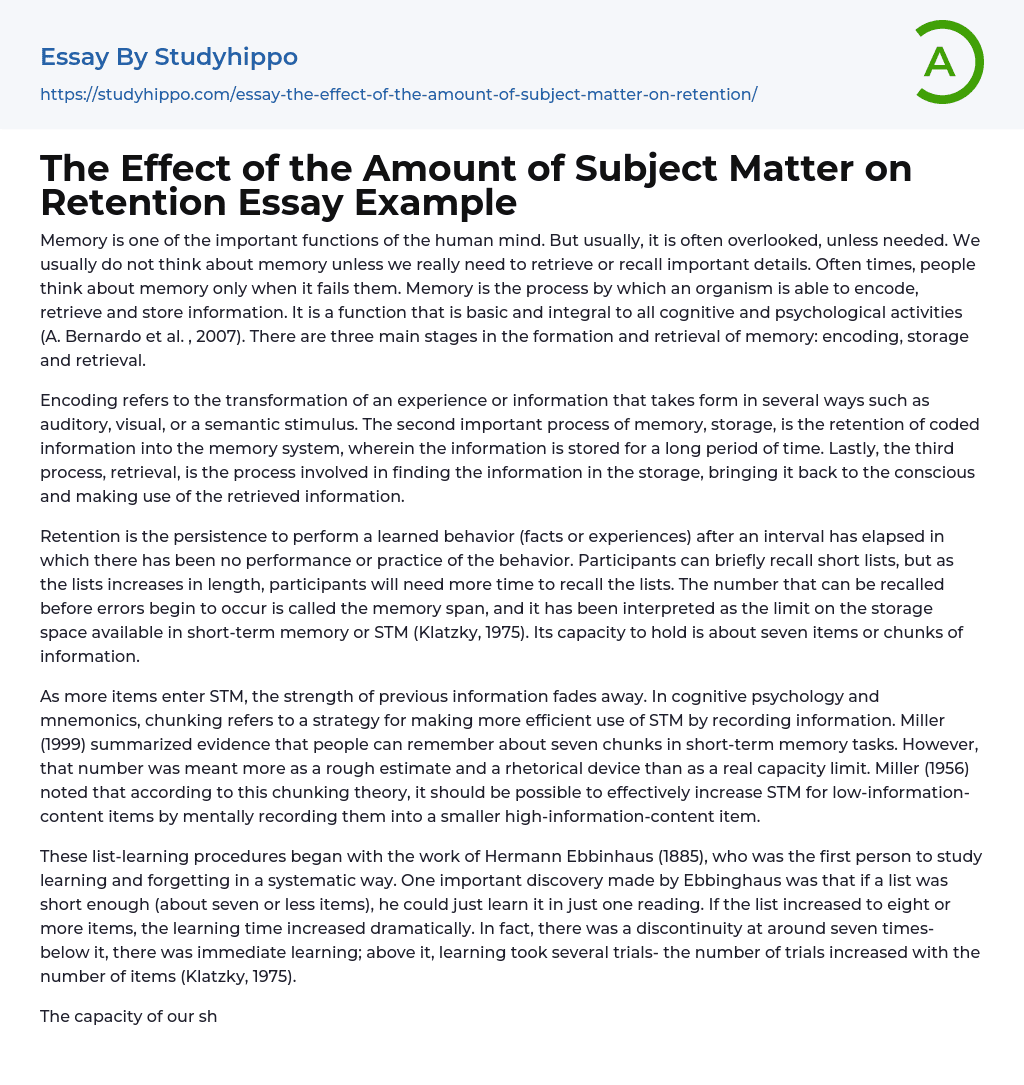

The Effect of the Amount of Subject Matter on Retention Essay Example
Memory is one of the important functions of the human mind. But usually, it is often overlooked, unless needed. We usually do not think about memory unless we really need to retrieve or recall important details. Often times, people think about memory only when it fails them. Memory is the process by which an organism is able to encode, retrieve and store information. It is a function that is basic and integral to all cognitive and psychological activities (A. Bernardo et al. , 2007). There are three main stages in the formation and retrieval of memory: encoding, storage and retrieval.
Encoding refers to the transformation of an experience or information that takes form in several ways such as auditory, visual, or a semantic stimulus. The second important process of memory, storage, is the retention of coded information
...into the memory system, wherein the information is stored for a long period of time. Lastly, the third process, retrieval, is the process involved in finding the information in the storage, bringing it back to the conscious and making use of the retrieved information.
Retention is the persistence to perform a learned behavior (facts or experiences) after an interval has elapsed in which there has been no performance or practice of the behavior. Participants can briefly recall short lists, but as the lists increases in length, participants will need more time to recall the lists. The number that can be recalled before errors begin to occur is called the memory span, and it has been interpreted as the limit on the storage space available in short-term memory or STM (Klatzky, 1975). Its capacity to hold is about seven items o
chunks of information.
As more items enter STM, the strength of previous information fades away. In cognitive psychology and mnemonics, chunking refers to a strategy for making more efficient use of STM by recording information. Miller (1999) summarized evidence that people can remember about seven chunks in short-term memory tasks. However, that number was meant more as a rough estimate and a rhetorical device than as a real capacity limit. Miller (1956) noted that according to this chunking theory, it should be possible to effectively increase STM for low-information-content items by mentally recording them into a smaller high-information-content item.
These list-learning procedures began with the work of Hermann Ebbinhaus (1885), who was the first person to study learning and forgetting in a systematic way. One important discovery made by Ebbinghaus was that if a list was short enough (about seven or less items), he could just learn it in just one reading. If the list increased to eight or more items, the learning time increased dramatically. In fact, there was a discontinuity at around seven times- below it, there was immediate learning; above it, learning took several trials- the number of trials increased with the number of items (Klatzky, 1975).
The capacity of our short-term memory can not only be seen with lists but also with letters. Such is the case with George Sperling’s research in iconic storage through whole-report procedure- in which the subject is requested to recall the whole list, or as much of it as he can. Sperling’s (Averbach and Sperling, 1961) results were quite consistent: how well the subjects performed depended on how many letters they viewed. The subject can report no more than
about five letters (Klatzky, 1975).
The memory span is not defined in terms of any particular unit- word, letter, or syllable- but instead seems to be about seven of whatever units are presented (Klatzky, 1975). The present study is very similar to the previous study. Both previous and present studies were about learning capacities and reasons for forgetting. The difference between Ebbinghaus’ study with the present study is that Ebbinghaus included time as one of the significant variables while we only focused on the amount of subject matter that was presented.
In Sperling’s study, he used letters instead of numbers. Otherwise, the conditions of both studies were the same. The purpose of this study was to determine the influence of the amount of materials to be learned upon retention. The influence of the subject matter was determined by its division into three parts. Total digits recalled was recorded and compared. With the data gathered after the experiment, differences between the group recall can be analyzed and interpreted.
- Acceptance essays
- Age Of Enlightenment essays
- Child Observation essays
- Confucianism essays
- Conscience essays
- Critical Reflection essays
- Destiny essays
- Determinism essays
- Empiricism essays
- Environmentalism essays
- Epistemology essays
- Ethics essays
- Ethos essays
- Existence essays
- Existentialism essays
- Fate essays
- Free Will essays
- Functionalism essays
- Future essays
- Good And Evil essays
- Human Nature essays
- Individualism essays
- Meaning Of Life essays
- Metaphysics essays
- Natural Law essays
- Personal Philosophy essays
- Philosophers essays
- Philosophy Of Life essays
- Political Philosophy essays
- Pragmatism essays
- Reality essays
- Relativism essays
- Teaching Philosophy essays
- Time essays
- Transcendentalism essays
- Truth essays
- Utilitarianism essays
- John Locke essays
- 9/11 essays
- A Good Teacher essays
- A Healthy Diet essays
- A Modest Proposal essays
- A&P essays
- Academic Achievement essays
- Achievement essays
- Achieving goals essays
- Admission essays
- Advantages And Disadvantages Of Internet essays
- Alcoholic drinks essays
- Ammonia essays



